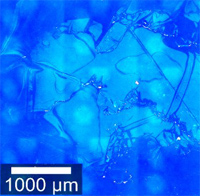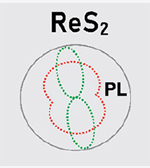Besides graphene, there are many more two-dimensional materials with interesting mechanical, optical and electronic properties. Among them are semiconducting transition-metal dichalcogenides (TMDCs) such as MoS2, which show beneficial properties for applications as optoelectronic materials such as active films for PV devices: they have high absorption coefficients, band gap tunable by composition, and efficient carrier multiplication. In general, these materials feature atomic layers that are only weakly bonded by van der Waals interactions. Similar to graphite, these materials can be easily exfoliated mechanically using simple scotch tape, or split into nanosheets by liquid exfoliation.
We exfoliate milimetre-size atomic monolayers using gold-assisted exfoliation, in which an ultra-smooth gold surface with strong adhesion to the exfoliated TMDC helps in exfoliating large areas. We then investigate the structural, optical and excitonic properties by Raman, Absorption, and time-resolved Photoluminescence spectroscopy. The exfoliated materials can be stacked, or combined with other materials such as nanocrystal layers to produce heterostructures. These heterostructures can be used to tailor exciton and charge transfer across the interface, depending on the band alignment of the two components,
Another intriguing property of graphene and other 2D materials (such as MoS2) is their ultralow friction, known as superlubricity. We exploit this property to design low-friction lubricants for applications. In the EU project SSLiP, we aim to scale up superlubricity using (colloidal) particles coated with graphene and MoS2.

Gold-assisted exfoliation
We exfoliate milimetre-size monolayers of MoS2 and other transition metal dichalcogenides using gold assisted exfoliation. Read more …

Interlayer interactions in ReS2
Rhenium disulfide (ReS2) is unique among the transition metal dichalcogenides exhibiting monolayer-like excitonic properties even in the bulk. We investigate the origin of these properties using angle-resolved Raman and PL combined with DFT calculations. Read more …
Read also our paper in ACS Photonics.